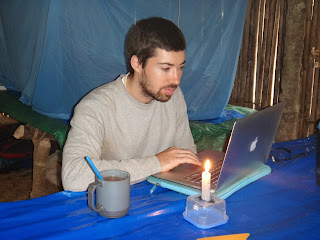Daily life while conducting fieldwork in the Amazon is drastically different than life in the U.S. or any city for that matter, i.e. No running water, no electricity, and a stray mosquito or two :)
Since Asher's research deals with water, we'll start there. In Campo Bello (the close village), there are several options for water: the river, wells, and pumps. We get our water from a pump that is about a five to six minute walk from the house we are renting. We usually get 20 liters of water when we wake up around 6:30am, at lunch around 1pm, and in the evening before dinner around 5pm. The pump is a good workout.
To minimize exposure to parasites and other things that might make us sick, we filter the water that we drink and the water that we cook with. We have a Lifesaver Jerrycan water filter. It can hold 20 liters and is one of the best water filters in the world - it filters down to 15 nanometers, meaning it can even filter out all bacteria, cysts, viruses and waterborne pathogens (for reference, the smallest known virus is polio at 25 nanometers). Depending on the turbidity of the water, it can filter 2-3 liters of water in just a couple of minutes (remarkably fast): If you need any water filters, personal water bottles Lifesaver has great options.
For electricity, we have a great solar panel power system. Thanks to Alan Schultz, we got a pretty elaborate system. For a detailed discussion about solar panel systems for fieldwork, see his awesome blog: Anthrohacker.
Here are our three panels getting lots of sunlight in front of our house.
The solar panel connection comes into the house and is connected to 2 morningstar solar controllers, which then attach to a lead acid car battery. We can then plug our computers, lights and a fan through the battery.
In terms of cooking, we cook on a propane stove (much easier than cooking over a fire). For breakfast, we usually have oatmeal and coffee/hot chocolate. For lunch and dinner, we have rice or pasta, canned meat (tuna, sardines, or spam) with onion or other vegetables, and plantains. Sometimes we make a quinoa or lentil soup to change things up. Here is our kitchen.
We eat breakfast at 7am, lunch at noon, and dinner at 7pm. From 8-12 and 2-5, we visit households around the community with Dino (Asher's translator). In Campo Bello, houses are on both sides of the river, so we often have to cross the river on canoe. Here's Dino navigating the canoe on the river for us.
The community is large - it is nearly an hour to walk between some of the households. Most days, we walk between six and ten miles.
We had a private area built for showering. We share it with lots of ants and even some mosquitos, but it serves its purpose well. We also have a latrine, but we'll spare you a picture.
Kelly had minimal demands in coming to the Amazon. The one thing she did request was a shower bag. We brought a 5 gallon shower bag from Seattle Sports. We fill it up in the morning, put it in the sun, and shower when we finish research for the day at 5pm. There's a bit of a rush each day when we finish data collection. The mosquitos come out to feed around 6, so we have to get water, bathe, and do our laundry quickly before the mosquito hour.
We are looking forward to spending some time in the far village (Anachere) in December and will update later about life there.











When can I visit?
ReplyDeleteEco-lodge will be open for business when we get back Dec. 1st
Delete